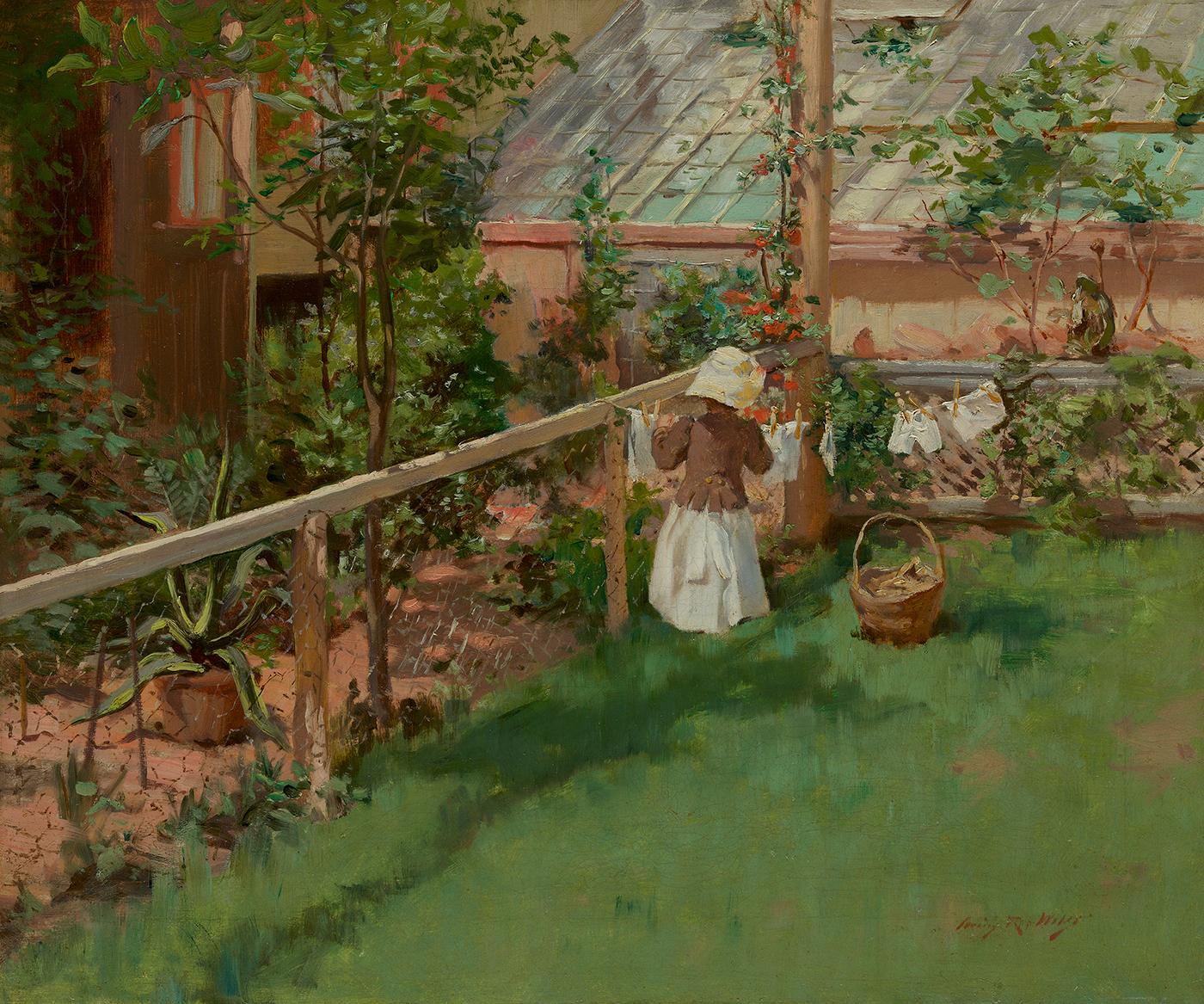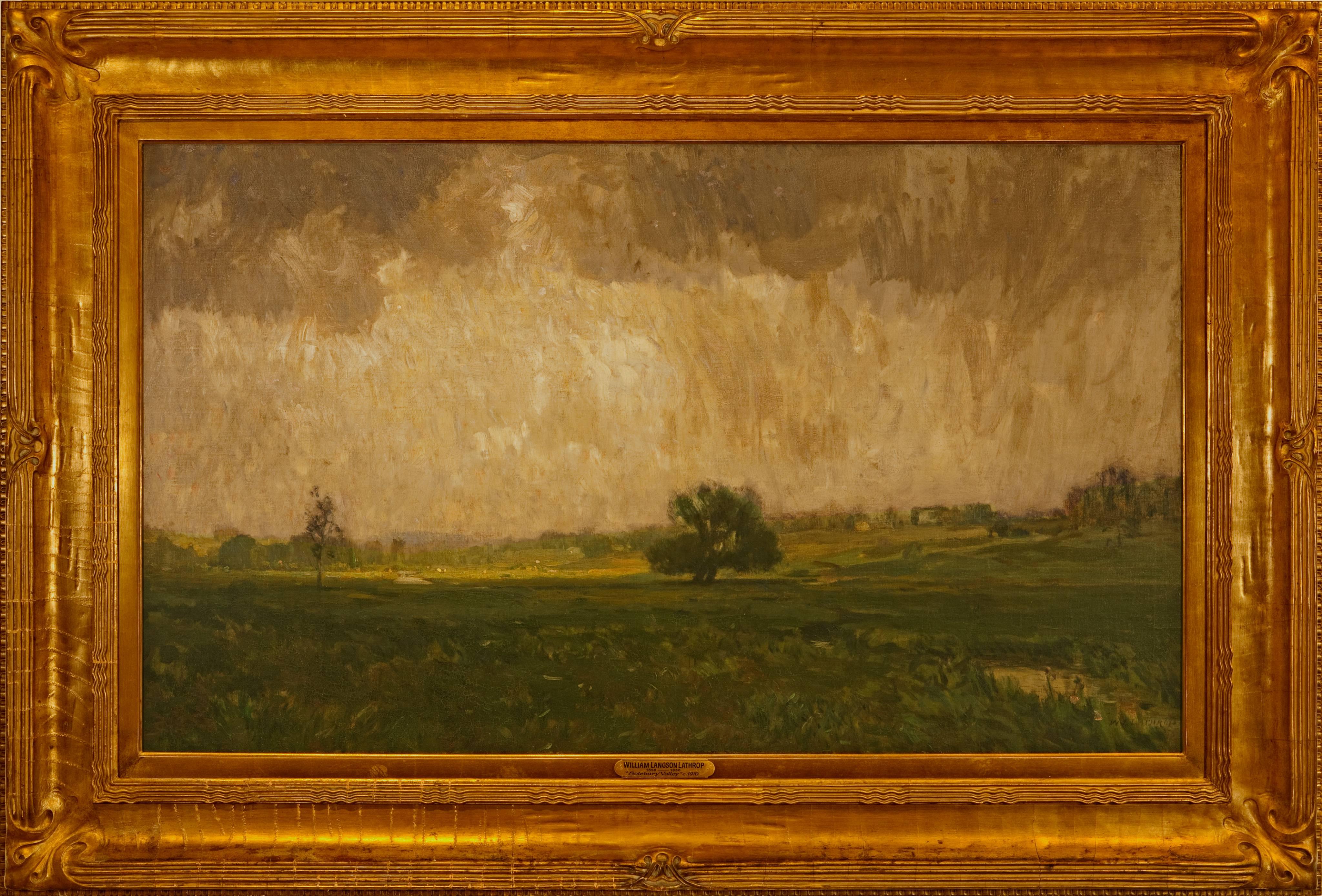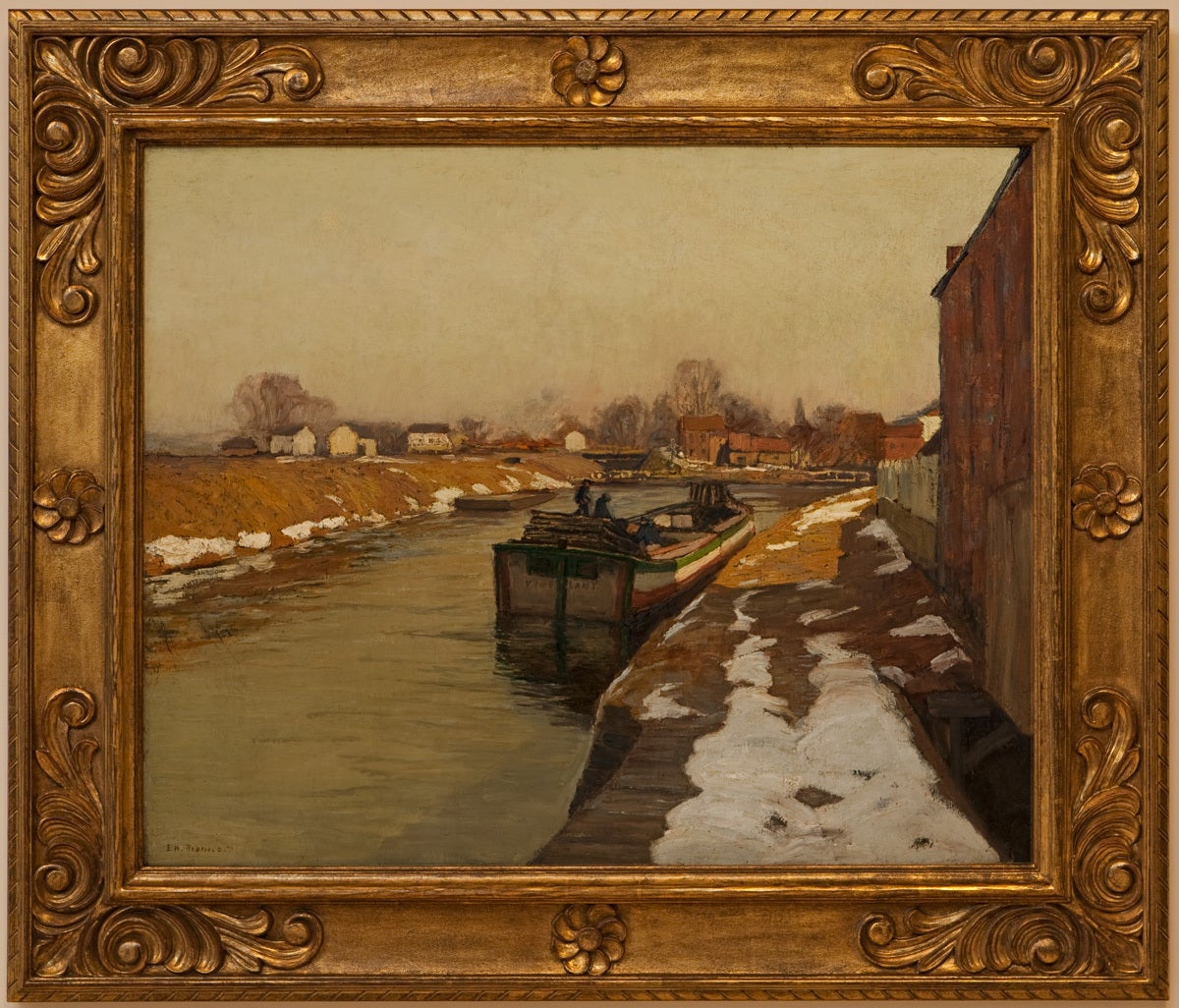John Fulton FolinsbeeSummer Farm, American Impressionist, Oil, Landscape, New Hope, Pennsylvania
About the Item
- Creator:John Fulton Folinsbee (1892-1972, American)
- Dimensions:Height: 23 in (58.42 cm)Width: 27 in (68.58 cm)
- Medium:
- Movement & Style:
- Period:
- Condition:This painting is in fine condition. The painting itself measures 16" x 20".
- Gallery Location:Wiscasset, ME
- Reference Number:1stDibs: LU7527299152
John Fulton Folinsbee
One of the finest painters to embark upon the New Hope Art Colony, John Fulton Folinsbee, did so in 1916. Born in Buffalo, New York, he was an active young man who enjoyed playing sports and swimming like most. In the summer of 1906, while on a family vacation in Sea Cliff, Long Island, Folinsbee (nicknamed Jack) felt extremely tired while swimming in the bay. Barely making it back to shore, he collapsed stricken with polio. Almost taking his life, the attack left his legs paralyzed and his right arm badly weakened. Polio would confine him to a wheelchair for the rest of his life. Making bad times even worse, one-week later Folinsbee’s older brother was killed in a diving accident. Faced with these adversities, he made the best of his situation. Determined not to let this handicap keep him down, he enrolled at the Art Students League in Woodstock, New York, under the tutelage of Birge Harrison and John F. Carlson in 1912. These two men would prove to be powerful influences in the development of his career. It was there that Folinsbee met his lifelong friend and the best man at his wedding, fellow artist, Harry Leith-Ross. Folinsbee married Ruth Baldwin in 1914, and two years later, upon the suggestion of Birge Harrison, the couple moved permanently to New Hope. Folinsbee and Ruth had two daughters together named Elizabeth and Joan. Folinsbee said of Harrison, “I perhaps owe more to Mr. Harrison in the development of my work and the influence of his friendship on my character than to any other man," and of John F. Carlson, “I am very grateful of the instruction given to me by John Carlson. I needed it.” In 1924, Folinsbee bought a piece of property along the Delaware River on Main Street in New Hope, where he had a home designed and built by artist and architect, Morgan Colt. This remained Folinsbee’s home and studio for the rest of his life. Folinsbee, early in his career (1912–24) painted in a heavy impressionist style with tightly applied broken brushstrokes similar in technique to the works of Childe Hassam. In the mid and later 1920s and into the 1930s, his brushstrokes broadened. His figurative works from this period have a strong Ashcan feeling. In the late 1930s and into the 1940s, his strokes became even broader and eventually, he employed the use of a palette knife for the application of paint. In the summer, Folinsbee often traveled to Maine with his family, where he would load the equipment into a small boat and head out to paint. He learned to adapt to almost any situation, not allowing his disability to hold him back. There are few in the field of 20th century American painting that rivals the ability of Folinsbee. He was truly one of New Hope’s finest artists. Folinsbee’s work has been represented in numerous important national exhibitions from 1913–70 and was the recipient of many medals, prizes and awards. His work is in the permanent collections of the Pennsylvania Academy of the Fine Arts, the Rhode Island School of Design, the National Academy of Design, the Phillips Collection in Washington, the Corcoran Gallery of Art, the Museum of Fine Arts in Houston, the New Jersey State Museum, Princeton University Art Museum, the Philadelphia Art Club, the Reading Public Museum, the National Art Club and the James A. Michener Art Museum, among others.

- ShippingRetrieving quote...Ships From: Wiscasset, ME
- Return PolicyA return for this item may be initiated within 14 days of delivery.
- Afternoon Stroll, American Impressionist, Figure on Forest Path, LandscapeLocated in Wiscasset, MEJuliet M. White was born in Philadelphia in 1880. She studied at the Philadelphia School of Design for Women, which became the largest art school for women in the United States. Its ...Category
20th Century American Impressionist Figurative Paintings
MaterialsBoard, Oil, Canvas
- In the Park, American Impressionist, Mother and Child, Landscape, Figures, OilLocated in Wiscasset, MEBorn in Philadelphia John Hamilton was known for portraits, figure paintings and illustrations. He studied at the Pennsylvania Academy of the Fine Arts with Christian Schuessel and Thomas Eakins and then traveled to Europe where he studied in Paris with Jean-Léon Gerome at the Ecole des Beaux-Arts and at the Royal Academy of Fine Arts in Antwerp. He lived abroad, mostly in London, for many years, although he maintained a Philadelphia address. He was the official painter to the English Prime Minister, William...Category
Late 19th Century American Impressionist Figurative Paintings
MaterialsOil, Canvas
- Harborfront, American Impressionist, 20th Century, Wooden Sailing Ships at DockLocated in Wiscasset, MEIn "Harborfront" the artist uses colorful, impressionist brushstrokes to bring a working waterfront to life.Category
20th Century American Impressionist Landscape Paintings
MaterialsCanvas, Oil, Board
- Summer Garden, Attributed to Edward Francis Rook, Jr., American ImpressionistLocated in Wiscasset, ME"Summer Garden" is attributed to Edward Francis Rook, Jr., who was born in New York City in 1870. He was a student of Benjamin Constant and Jean-Paul Laurens at the Académie Julian. He exhibited at the Cincinnati Art Museum and at the Pennsylvania Academy of the Fine Arts where he was presented with the Temple Gold Medal for Deserted Street, Moonlight, the first of many awards. Rook visited Old Lyme in October of 1903 when Childe Hassam was also there, and two years later moved to Old Lyme. He was one of the relatively young painters to come to Old Lyme, along with Gifford Beal, William Chadwick...Category
Early 20th Century American Impressionist Landscape Paintings
MaterialsOil, Board
- San Giorgio Maggiore, Venice, Italy, American Impressionist, OilBy Charles Merrill MountLocated in Wiscasset, MECharles Merrill Mount was born Sherman Merrill Suchow in Brooklyn, New York in 1928. Mount attended Columbia University, leaving to study at the Art Students League of New York. In a...Category
Mid-20th Century American Impressionist Landscape Paintings
MaterialsBoard, Oil
- Pont des Arts, ParisBy André GissonLocated in Wiscasset, MEBorn Anders Gittelson, painter André Gisson adopted the brush name Gisson to emphasize his connection with the French Impressionists. Born in Brooklyn, New York in 1921, Gisson studi...Category
1950s Impressionist Landscape Paintings
MaterialsOil, Canvas
- At the ClotheslineBy Irving Ramsey WilesLocated in New York, NYSigned lower right: Irving R. WilesCategory
Late 19th Century American Impressionist Landscape Paintings
MaterialsCanvas, Oil
- "Alley Fiends"By John R. GrabachLocated in Lambertville, NJJim’s of Lambertville is proud to offer this artwork by: John R. Grabach (1886 - 1981) John Grabach was a highly regarded New Jersey artist, teacher, and author of the classic text...Category
1930s American Impressionist Landscape Paintings
MaterialsCanvas, Oil
- "Forest Strongholds"By John F. CarlsonLocated in Lambertville, NJSigned lower right. Complemented by a hand carved and gilt frame. Exhibited at the National Academy of Design, 1928Category
20th Century American Impressionist Landscape Paintings
MaterialsCanvas, Oil
- "Solebury Valley"By William Langson LathropLocated in Lambertville, NJSigned lower right. Complemented by a period frame. William L. Lathrop (1859-1938) Deemed “Father of the New Hope Art Colony”, William Langson Lathrop was born in Warren, Illinois. He was largely self-taught, having only studied briefly with William Merritt Chase in 1887, at the Art Students League. Lathrop first moved east in the early 1880s, and took a job at the Photoengraving Company in New York City. While there, he befriended a fellow employee, Henry B. Snell. The two men became lifelong friends and ultimately, both would be considered central figures among the New Hope Art Colony. Lathrop's early years as an artist were ones of continuing struggle. His efforts to break through in the New York art scene seemed futile, so he scraped enough money together to travel to Europe with Henry Snell in1888. There he met and married an English girl, Annie Burt. Upon returning to New York, he tried his hand at etching, making tools from old saw blades...Category
1910s American Impressionist Landscape Paintings
MaterialsCanvas, Oil
- Winter MoonlightBy George William SotterLocated in Lambertville, NJsigned lower rightCategory
1910s American Impressionist Landscape Paintings
MaterialsCanvas, Oil
- "The Canal"By Edward Willis RedfieldLocated in Lambertville, NJJim’s of Lambertville is proud to offer this artwork. Signed lower left. Complemented by a hand carved and gilt frame. Illustrated in "Edward Redfield: Just Values and Fine Seeing" by Constance Kimmerle and the Pennsylvania Academy of the Fine Arts's Exhibition of Paintings by Edward Redfield (April 17 to May 16, 1909) brochure Edward Willis Redfield (1869 - 1965) Edward W. Redfield was born in Bridgeville, Delaware, moving to Philadelphia as a young child. Determined to be an artist from an early age, he studied at the Spring Garden Institute and the Franklin Institute before entering the Pennsylvania Academy from 1887 to 1889, where he studied under Thomas Anshutz, James Kelly, and Thomas Hovenden. Along with his friend and fellow artist, Robert Henri, he traveled abroad in 1889 and studied at the Academie Julian in Paris under William Bouguereau and Tony Robert-Fleury. While in France, Redfield met Elise Deligant, the daughter of an innkeeper, and married in London in 1893. Upon his return to the United States, Redfield and his wife settled in Glenside, Pennsylvania. He remained there until 1898, at which time he moved his family to Center Bridge, a town several miles north of New Hope along the Delaware River. Redfield painted prolifically in the 1890s but it was not until the beginning of the twentieth century that he would develop the bold impressionist style that defined his career. As Redfield’s international reputation spread, many young artists gravitated to New Hope as he was a great inspiration and an iconic role model. Edward Redfield remained in Center Bridge throughout his long life, fathering his six children there. Around 1905 and 1906, Redfield’s style was coming into its own, employing thick vigorous brush strokes tightly woven and layered with a multitude of colors. These large plein-air canvases define the essence of Pennsylvania Impressionism. By 1907, Redfield had perfected his craft and, from this point forward, was creating some of his finest work. Redfield would once again return to France where he painted a small but important body of work between 1907 and 1908. While there, he received an Honorable Mention from the Paris Salon for one of these canvases. In 1910 he was awarded a Gold Medal at the prestigious Buenos Aires Exposition and at the Panama-Pacific Exposition of 1915 in San Francisco, an entire gallery was dedicated for twenty-one of his paintings. Since Redfield painted for Exhibition with the intent to win medals, his best effort often went into his larger paintings. Although he also painted many fine smaller pictures, virtually all of his works were of major award-winning canvas sizes of 38x50 or 50x56 inches. If one were to assign a period of Redfield’s work that was representative of his “best period”, it would have to be from 1907 to 1925. Although he was capable of creating masterpieces though the late 1940s, his style fully matured by 1907 and most work from then through the early twenties was of consistently high quality. In the later 1920s and through the 1930s and 1940s, he was like most other great artists, creating some paintings that were superb examples and others that were of more ordinary quality. Redfield earned an international reputation at a young age, known for accurately recording nature with his canvases and painting virtually all of his work outdoors; Redfield was one of a rare breed. He was regarded as the pioneer of impressionist winter landscape painting in America, having few if any equals. Redfield spent summers in Maine, first at Boothbay Harbor and beginning in the 1920s, on Monhegan Island. There he painted colorful marine and coastal scenes as well as the island’s landscape and fishing shacks. He remained active painting and making Windsor style furniture...Category
Early 1900s American Impressionist Landscape Paintings
MaterialsCanvas, Oil






